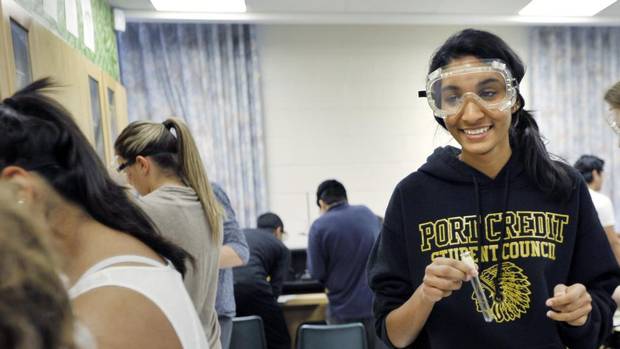Growing up, Ruqaiyah Baksh always wanted to be a chemical engineer. But once she got to high school, the 17-year-old straight-A student reconsidered, and now she hopes to study business at university instead.
“I love sciences, I do, but I just don’t see myself doing that in the future,” she said Monday, after stepping out of her Grade 12 music class at Port Credit Secondary School in Mississauga for an interview.
Ms. Baksh is part of a stubborn trend, one that has educators and industry leaders scratching their heads as to how to attract women to jobs in science, technology, engineering and math (STEM).
Standardized test scores released Tuesday show that at the Grade 8-level girls have closed the gap in science and math, performing as well and sometimes better than their male classmates. But participation in those courses begins declining in high school and drops further in university: Females account for just 39 per cent of undergrads in math and physical sciences and only 17 per cent of undergraduates in engineering and computer science, according to data from the Natural Sciences and Engineering Research Council of Canada.
“This is something that we all want to pay attention to, these fields are hugely important to our economy and our standing in the world,” said Gordon Dirks, chair of Canada’s Council of Ministers of Education, the agency that released the standardized test results known as the Pan-Canadian Assessment Program (PCAP).
The test, which was administered to 32,000 students in 2013, showed that Grade 8 girls in all 10 provinces are making gains. For example, the latest results show that girls are outperforming boys in math in seven out of 10 provinces, compared to four out of 10 in 2010.
There have been some modest gains at the postsecondary level. The proportion of female engineering students in Ontario climbed from 17.3 to 19.4 per cent between 2005 and 2012, according to data collected by the Ontario Network for Women in Engineering.
Despite the gains, countries such as Turkey, India and China – where jobs in science and engineering are seen as highly desirable rather than nerdy – are leading the way in improving the gender balance in STEM fields.
“Girls in North America view high-tech and engineering fields as nerdy, for people who don’t have good social skills,” said Lorraine Dyke, a professor at Carleton University’s Sprott School of Business.
They start dropping out of science and math courses in high school, she said, at a time when they are most susceptible to peer pressure and the perceptions of others.
The creators of Ladies Learning Code, a non-profit that aims to engage women in designing Web pages and developing other computer skills, recently conducted focus groups for teenage girls to find out why their interest in STEM drops after elementary school.
“They’re really looking for social, collaborative, creative experiences, and I think the stereotypes that exist around technology, it being for men or it being very anti-social … I think that really starts to turn them away,” said Melissa Sariffodeen, co-executive director of the non-profit.
Studies have shown that parents – especially mothers – are a major influence on students’ perceptions of sciences and math.
Marie-Claire Shanahan, research chair in science education and public engagement at the University of Calgary, said that while many parents take their children to the science centre, for example, at a young age, parent engagement and encouragement drops off in later years.
“There’s very little on how to really engage parents and families as students become 11, 12, and are into their teens,” Prof. Shanahan said. “Often parents, really well-intentioned parents, still carry this societal idea that girls either aren’t interested in science or aren’t as good at it, and that comes through in the types of things they encourage their daughters to do.”
Ms. Baksh is applying to the University of Western Ontario’s Ivey program. She says she still loves learning about science, but is looking for a career that will allow her to write and lead people.
“I see my uncle who is a scientist and he’s in a lab all day,” she said. “I don’t see myself doing that, there’s no social aspect to it. I like interacting with others.”
KATE HAMMER AND CAROLINE ALPHONSO
The Globe and Mail
Published Tuesday, Oct. 07 2014, 5:00 AM EDT
Last updated Tuesday, Oct. 07 2014, 9:10 AM EDT

